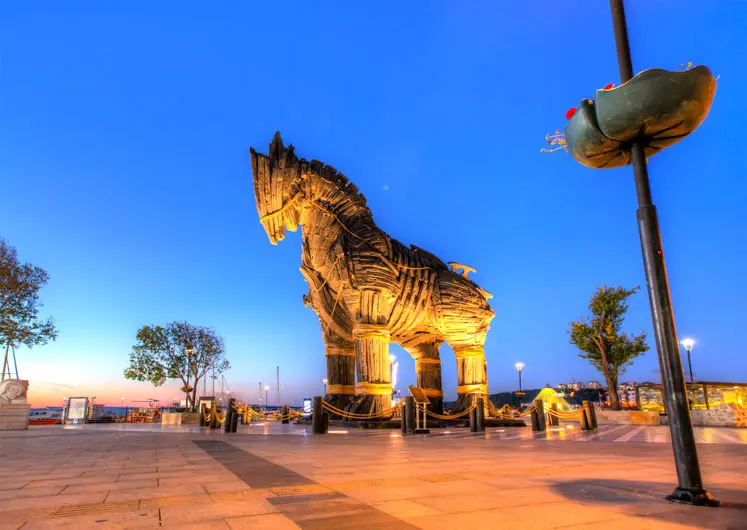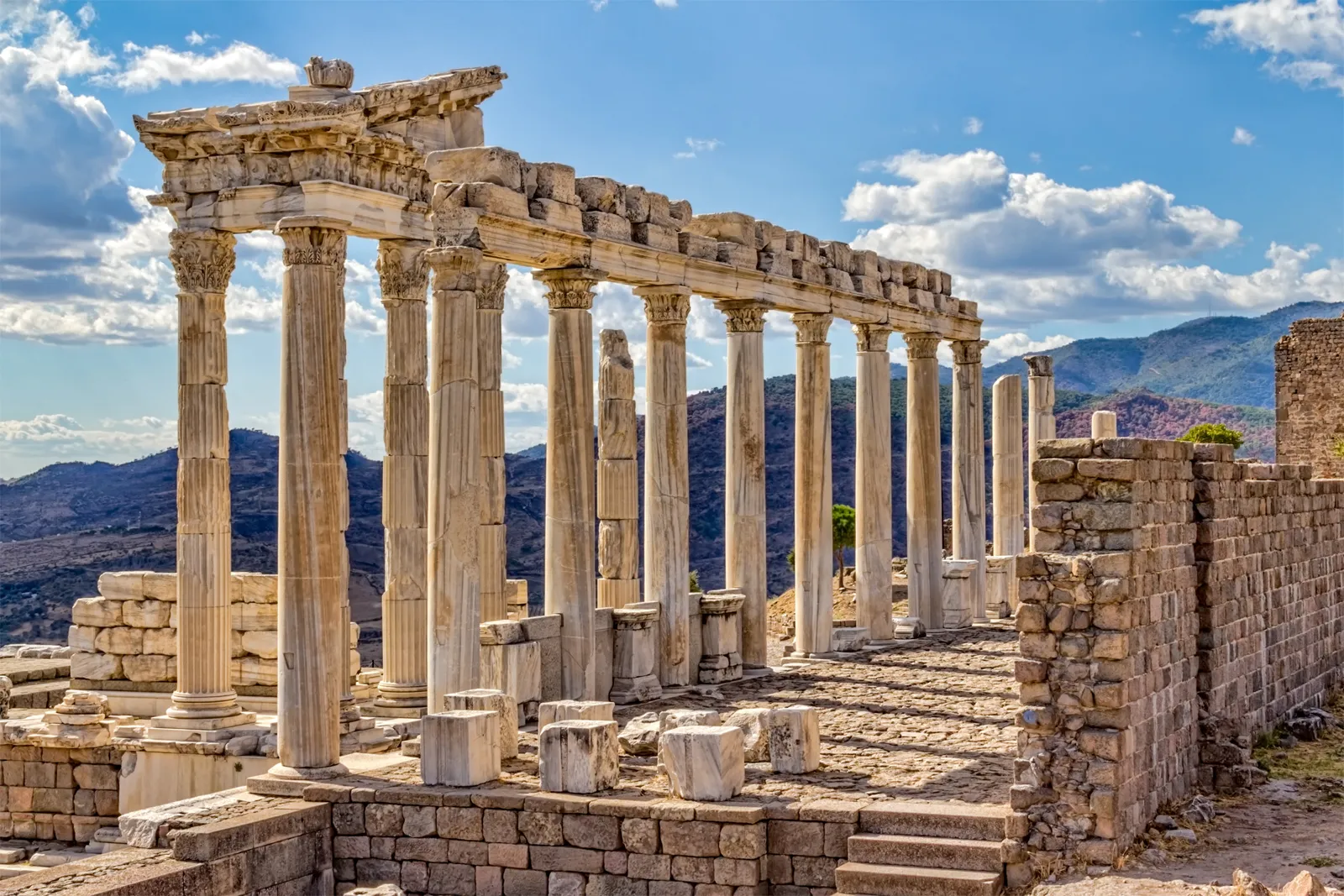Turkey is home to some of the world’s most significant and well-preserved ancient ruins, reflecting its rich historical tapestry. From the ancient city of Ephesus to the legendary site of Troy and the grand acropolis of Pergamon, these ruins offer a journey through time, showcasing the achievements of ancient civilizations. Let’s explore these iconic archaeological sites in Turkey.
1. Ephesus: The Jewel of the Roman Empire
Ephesus is one of the best-preserved ancient cities in the world and a UNESCO World Heritage Site. Once a bustling metropolis and a major trading center of the Roman Empire, it’s famous for its grand architecture, temples, and its connection to early Christianity.
Key Highlights:
- Library of Celsus
One of the most iconic structures in Ephesus, the Library of Celsus was built in 117 AD to honor the Roman senator Tiberius Julius Celsus. It once held thousands of scrolls and served as a mausoleum for Celsus. Its grand façade, with intricate carvings and towering columns, is still remarkably well-preserved. - The Great Theatre
This massive structure, which could seat 25,000 people, is one of the largest ancient theaters in the world. It was used for concerts, theatrical performances, and political gatherings, and it offers a stunning view of the surrounding area. Today, it is sometimes still used for performances. - Temple of Artemis
Once one of the Seven Wonders of the Ancient World, the Temple of Artemis in Ephesus was an awe-inspiring monument dedicated to the goddess Artemis. Though only a single column remains today, its historical significance makes it a must-see for history enthusiasts. - Terrace Houses
Located on the slopes of Bülbül Mountain, the Terrace Houses of Ephesus were luxurious residences of the city’s elite. The mosaics, frescoes, and intricate designs that decorate these homes provide insight into the lifestyle of the wealthy during the Roman period. - The House of the Virgin Mary
Located near Ephesus, this small stone house is believed to be the last residence of the Virgin Mary. It’s a site of pilgrimage for Christians and offers a peaceful atmosphere surrounded by greenery.
Visiting Tips:
- Best Time to Visit: Spring (April to June) and fall (September to November) for milder weather.
- Guided Tours: Opt for a guided tour to get deeper insights into the history and significance of the ruins.
- Nearby Town: Selçuk, a charming town near Ephesus, is a great base for exploring the site and other nearby attractions.
.jpg)
2. Troy: The Legendary City of the Iliad
Troy, made famous by Homer’s Iliad, is an ancient city steeped in legend and myth. Located near the modern town of Hisarlik, the site offers a glimpse into multiple layers of ancient civilizations and remains one of the most important archaeological sites in the world.
Key Highlights:
- The Trojan Horse
A modern reconstruction of the Trojan Horse stands at the entrance of the site, symbolizing the legendary tale of the Greek siege. While not an original artifact, it serves as a fun photo opportunity and a reminder of the myth that made Troy famous. - The City Walls
The remains of Troy’s massive defensive walls, built during different phases of its existence, are still visible today. These walls, particularly those from the legendary Troy VI, are believed to be the ones referenced in the Iliad. - Schliemann’s Trench
The trench dug by German archaeologist Heinrich Schliemann in the 19th century is a stark reminder of the early days of archaeological exploration. While Schliemann’s methods were crude, his discoveries helped confirm that Troy was more than just a myth. - Nine Layers of Troy
Troy is unique in that it consists of nine different layers, each representing a different era of the city’s history. Visitors can see remnants from these various layers, ranging from the Bronze Age to the Roman period. - Ancient Altars and Temples
Scattered throughout the site are remnants of altars and temples dedicated to various gods, providing insight into the religious practices of the ancient Trojans.
Visiting Tips:
- Best Time to Visit: Early morning or late afternoon to avoid the midday heat, especially during summer.
- Nearby Attraction: The ancient city of Assos, located along the Aegean coast, offers additional historical exploration and stunning coastal views.
- Museum of Troy: Located near the site, this museum houses many of the artifacts uncovered at Troy, including pottery, tools, and other ancient relics.

3. Pergamon: The Grand Acropolis
Pergamon (or Pergamum), once a powerful city during the Hellenistic period, was a major center of learning, culture, and politics. Its impressive ruins sit atop a hill near the modern city of Bergama, offering stunning views of the surrounding area.
Key Highlights:
- The Acropolis
The Acropolis of Pergamon is perched on a high hill and was the political and cultural heart of the city. It offers spectacular views of the surrounding landscape and the remnants of grand temples and public buildings. - The Pergamon Altar
One of the most famous features of ancient Pergamon was its massive altar, dedicated to Zeus. While the original altar is now housed in the Pergamon Museum in Berlin, the site where it once stood is still visible. - The Library of Pergamon
Pergamon’s library was one of the largest in the ancient world, second only to the Library of Alexandria. It housed over 200,000 volumes, and legend has it that parchment (pergamenta) was invented here when the supply of papyrus from Egypt was cut off. - The Theatre of Pergamon
Built into the hillside, Pergamon’s theater is one of the steepest ancient theaters ever constructed. It could hold up to 10,000 spectators and offers a panoramic view of the city and its surroundings. - The Temple of Trajan
This Roman temple, dedicated to Emperor Trajan, sits high on the Acropolis and is one of the best-preserved structures in Pergamon. Its marble columns and intricate design are a testament to the architectural prowess of the Romans. - Asklepion
Located at the base of the Acropolis, the Asklepion was an ancient medical center dedicated to the god of healing, Asclepius. It’s one of the earliest health complexes in the world, where treatments like therapy, massages, and herbal remedies were practiced.
Visiting Tips:
- Best Time to Visit: Spring or fall to enjoy the comfortable weather.
- Cable Car Ride: Take the cable car from the base to the top of the Acropolis for easy access and spectacular views.
- Nearby Attractions: The Red Basilica (Kızıl Avlu) in Bergama, originally a temple dedicated to Egyptian gods, is another fascinating site to visit.

Conclusion
Turkey’s ancient ruins of Ephesus, Troy, and Pergamon offer an immersive journey into the past, showcasing the grandeur and complexity of ancient civilizations. Whether you’re walking through the streets of Ephesus, imagining the tales of Troy, or exploring the heights of Pergamon’s Acropolis, these archaeological sites provide a deep connection to history and the cultures that shaped the ancient world. Exploring these ruins will undoubtedly leave you with a sense of awe and appreciation for Turkey’s rich historical heritage.
